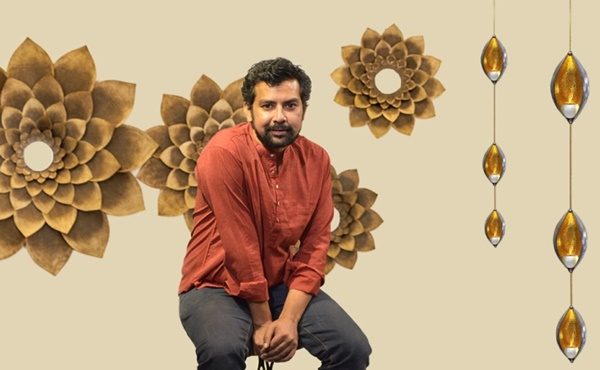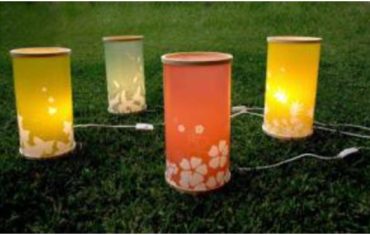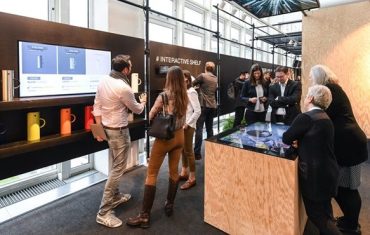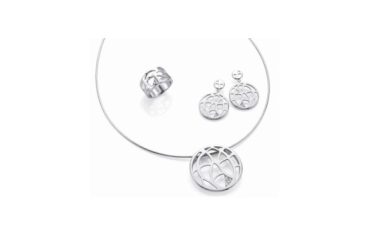Ayush Kasliwal is one of India’s top product designers and will be curating the 2019 Ambiente partner country presentation. His designs dig deep into the treasure trove of traditional crafts, while simultaneously showcasing a commitment to the modern. This approach proudly goes back to the future, and results in an astonishingly urban minimalism with a lot of Indian soul. In this interview he explains how tradition can underpin sustainability.
So you studied furniture design in a country which doesn’t have a strong tradition of furniture making!
True. Until 50 years ago, most Indian households did not contain any furniture. You sat on the floor, that was our tradition. Original reinterpretations of objects really interest me. The Bowl Table is one example―you can remove the legs and use it as either a large tray or a bowl. The table’s design also speaks a pared-down Scandinavian design language. In fact, I designed it for a Danish label; our studio thinks globally.
How does your homeland manifest itself in your designs?
There are the techniques, some of which are very old; the materials also inspire me―partly due to their natural colours. These are primarily various types of wood, but also copper, brass, bamboo and jute. India has a long history of working with these materials. Dyes also play a major role. Indigo, for example, has been important since time immemorial. Handmade items are the obvious choice for me, as we have such great resources in India, and many unbelievably talented craftspeople.

Are some designs particularly close to your heart?
I am of course particularly attached to our award-winning designs. One of these is the Trinetra tea light holder, made from a trio of hand-hammered brass bowls. The idea references Shiva’s third eye of enlightenment. With white marble tea light holders inside, the bowls do indeed light up like mystical eyes. Local Thathera metalworkers contributed their skills to this design, which won the UNESCO Award of Excellence. Then there’s the minimalist Shiva copper jug, with matching tray and cups. In 2017, this set won the Elle Decor International Design Award (EDIDA).
What is the philosophy that informs your work?
Objects are messages that have taken physical form. All the things around us state who we are, and this message is just as important as the object itself. Our studio’s philosophy is: ‘Never more than necessary, never less than beauty’. We pay as much attention to the underside of the chair as we do to the seat on top: it’s what honest design is all about. Sustainability is an important part of our philosophy. If someone feels an emotional connection to an object, it can promote sustainability. How long can you treasure an object you feel no connection to? Usually not very long. That’s why we design products that make a connection.
All the mudras on display relate to communication. Which is your favourite?
The abhaya mudra. It’s a gesture representing fearlessness. The raised open right hand blesses the recipient. The Canyon Wall shows the world something which characterises India. Mudras, dance and yoga―which I practice myself―are part of that. My religion is Jainism, and ‘ahimsa’ is an important teaching. It is a Sanskrit word meaning ‘fully distancing yourself from causing hurt or suffering to any living being, whether in thought, word or deed’.
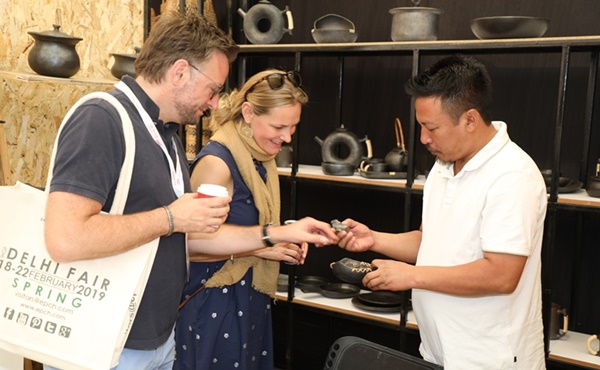
Is there anything typically Indian about your own home?
The flowers in our small garden. We grow roses and marigolds, which are orange like many Indian designs. India is all about the senses, we love fragrances in particular. A home should be a place of relaxation, and I enjoy our house with my architect wife Geetanjali and our three daughters. Each room belongs to all of us.
What is the current state of Indian design, what trends can you identify?
Modern design is still in its infancy here. Young designers try to adopt Western influences, yet their designs also express a strong sense of their own homeland. India itself is so culturally diverse that it’s impossible to establish a single trend or colour.
Who is your hero among Indian designers?
Definitely Rajeev Sethi. He has been working in design and architecture, performances and festivals for decades, trailblazing so that traditional craft workers and creative artists can use their skills in a meaningful, contemporary setting. His work is beautiful and presents a very strong visual representation of India. He also builds bridges between the product and its story. My heroes from Europe include Charles and Ray Eames and Hans J. Wegner.

How do you feel the interiors market in India has changed in recent years?
It has developed considerably. It used to be hard to find interior designers, but now there are a lot of good people. Indian interior design is increasingly making its presence felt on the international scene. There’s a lot of interest, particularly in Italy.
You are planning two areas for India’s partner country presentation: Handmade and Tradition. Will the show surprise us?
We’ll be displaying objects in an illuminated, gallery-type format. Simple Indian colours will dominate the display. Our selection of products makes it clear that ‘Handmade’ is one of India’s major strengths. Visitors will see products that have been developed to meet the high expectations of the international market, as well as a wide range of traditional, authentic originals. In the Tradition area we’ll present established craft businesses as well as first-timers. Our focus here will be on ways of working and production techniques. The audience will be inspired by the highly modern aesthetic of many such products.
This article originally appeared on the Ambiente blog by Messe Frankfurt.
The next Ambiente is held from 8-12 February 2019.



